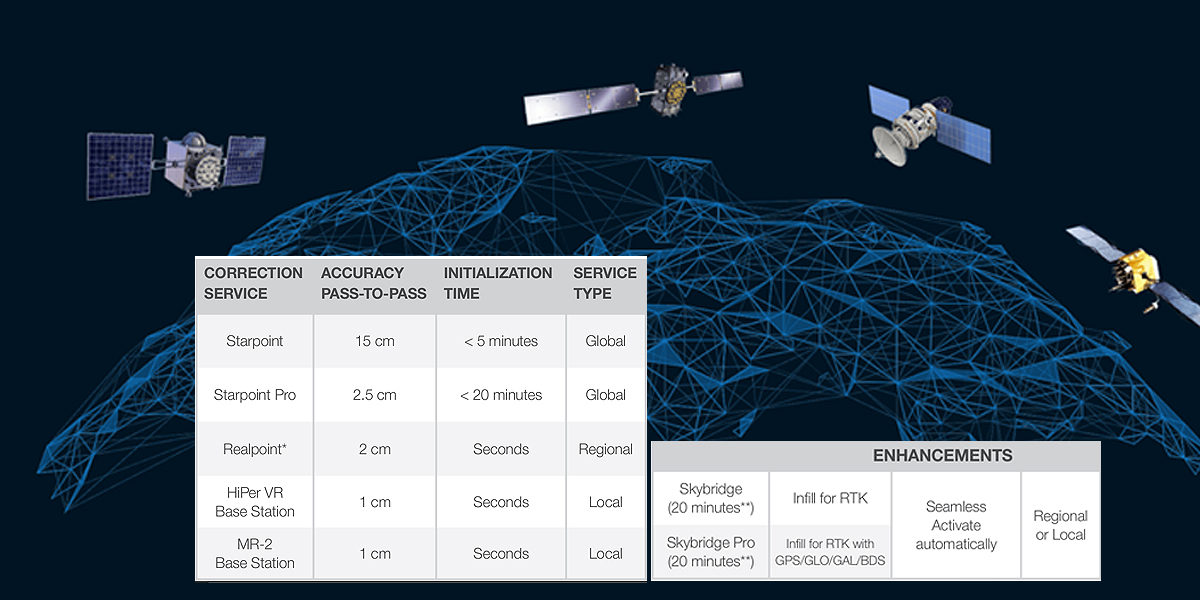Topcon’s Ian Stilgoe explores how the evolution of Global Satellite Navigation Systems (GNSS) technology is approaching a tipping point … one where consumer applications will rival those in specialized sectors, creating both new opportunities and challenges

GNSS technology has evolved from a niche tool for specialists to a fundamental part of industries ranging from agriculture to construction to transportation, driving greater efficiency and precision. Its seamless integration into so many aspects of so many industries highlights just how essential and versatile this technology has become.
Traditionally, GNSS developed has evolved in 10-year cycles, closely tied to advancements in mobile data networks. However, in recent years, this pace has accelerated dramatically, driven by new applications and growing mass-market demand.
Once confined to high-end, specialized applications, precise positioning is now becoming mainstream. Affordable chipsets and the growing availability of open GNSS signals are driving this shift, enabling new consumer applications. This presents remarkable opportunities, but it also introduces new challenges for the industry.
As traditional users of GNSS continue to harness the growing data power and knowledge within systems, the consumer market is just getting to grips with the basics, and this disconnect can be jarring. Too often, consumer-focused start-ups lack a full understanding of GNSS technology and its limitations – leading to situations where firms are overpromising and underdelivering and, ultimately, undermining faith in the technology itself. To ensure successful implementation, collaboration between these emerging companies and more established geospatial professionals is essential.
As we look to the future of GNSS technology, bridging the gap between traditional and consumer markets is crucial. This will not only ensure new applications deliver optimal outcomes for consumers but also ensure the benefits of this collaboration are realized across all sectors.
Mainstream applications enter the market
As GNSS technology becomes more affordable, it is powering an expanding range of consumer applications – from self-driving cars and delivery drones to autonomous robotic lawnmowers. What was once the domain of highly specialized and niche industries will soon be a staple in everyday consumer products.
The next step is making GNSS technology more accessible to consumers. Satellite communications will play a key role, particularly in overcoming the challenge of maintaining constant satellite visibility – an issue faced by both consumers and professionals in GNSS-denied areas.
One of the most promising developments is the integration of GNSS with Inertial Measurement Units (IMUs) and cameras. This combination enables advanced positioning and navigation, but it also requires specialized expertise in geospatial data processing to overcome the obstacle of low-satellite visibility.
Ensuring accurate and effective data fusion – combining GNSS, IMU, and camera inputs – is a key challenge. Companies developing these solutions must collaborate with geospatial experts to refine their algorithms and improve the reliability of positioning technology in real-world applications.
It’s clear these specialists have a job to do in educating the broader market and aligning consumer-focused applications with the true capabilities of GNSS technology. However, we are quickly approaching a tipping point where consumer applications will rival those in specialized sectors, creating both new opportunities and challenges for the GNSS market.

A turning point for traditional applications
For decades, GNSS has been a cornerstone of specialized sectors, where high-cost, high-precision solutions have delivered clear returns on investment for large-scale or multi-year usage. Industries like construction and agriculture, for example, have long been accustomed to paying a premium for the reliability of these systems – counting on the efficiency, accuracy and sustainability gains they will deliver year after year. The rise of consumer GNSS applications is disrupting this established model, presenting new challenges for providers.
As GNSS becomes more affordable and mainstream, traditional providers must adapt – balancing high-precision solutions for specialized industries with the growing demand for more accessible, cost-effective consumer applications. This shift requires companies to rethink their business models, pricing strategies, and value propositions to stay competitive in a rapidly evolving landscape, and it’s likely that we’ll start to see shifts in approach from industry leaders in this space.
Benefits for all markets
Despite the challenges, a growing presence in the consumer market presents an exciting opportunity for those in the GNSS sector. While some may be resistant to such a significant shift, the potential rewards are substantial.
One of the key benefits of GNSS’s expansion into consumer markets is the increased investment in research and development. As demand rises, innovation accelerates, leading to rapid breakthroughs in positioning technology advancements. A major area poised for growth is correction services, which are crucial for improving positioning accuracy.
Correction services are becoming more widely available across both consumer and traditional, professional markets. With a larger user base, providers can gather more data, enhancing the accuracy, availability, and speed of GNSS corrections. This is one of the most exciting developments in the field, as it bridges the gap between satellite-based GNSS signals and ground-based correction networks. This groundbreaking development connects satellite-based GNSS signals with ground-based correction networks, creating a more seamless service. These advancements will benefit both consumer and industrial applications, delivering more accurate, timely, and reliable positioning data.
This area is already being explored within specialized sectors. For example, our GNSS services provide seamless, high-accuracy positioning with uninterrupted service. Topnet Live delivers real-time correction data via a global network, ensuring centimeter-level accuracy. Should the connection be lost, SkyBridge Pro maintains precision for extended periods. StarPoint Pro, meanwhile, offers global satellite-based corrections, providing high accuracy even in remote areas.

However, the future of GNSS isn’t just about scaling existing technologies. It’s also about collaborating with key partners to create new applications that can serve both consumer and specialized sectors. By partnering with companies like DDK Positioning, a GNSS technology supplier for marine applications and vessels, and u-blox, a leading GNSS chipsets and RTK provider, Topcon is bridging the gap between sectors and helping to create one of the largest high-precision GNSS positioning service offerings available today.
This combination of expertise isn’t just advancing technology. There’s a wider benefit to the sector in terms of career development and skills attraction, and the greater the collaboration, the greater the benefits for the GNSS sector. As GNSS technology attracts more funding and companies seek innovative deployment strategies, the industry will see a surge in career opportunities and increased investment in training programs.
A positive outlook for traditional sectors
The expansion of GNSS correction services is transforming traditional industries by making high-precision positioning more accessible. Driven by consumer market innovations, this shift is unlocking significant benefits across multiple sectors.
In surveying and mapping, GNSS enhances accuracy in tasks like mapping, control points and reference data, reducing reliance on manual methods. With lower-cost solutions, these tools are becoming more accessible in sectors like construction and precision farming, boosting resource management, efficiency, and reducing errors.

In construction, GNSS supports machine control and field operations. Excavators and graders equipped with GNSS allow for precise grading and excavation. GNSS also improves earthworks, utility installation, and field management, providing accuracy in tasks such as trenching, pipe laying, and structural positioning.
In agriculture, GNSS enables precision farming by tracking field boundaries, irrigation lines, and the planting and harvesting processes, leading to better resource efficiency and higher yields.
New correction methods – such as RTK for centimetre-level accuracy, PPK for post-processing, SBAS for meter-level precision, and PPP for global corrections – are continuously improving GNSS reliability and accessibility across a range of applications.
The future of GNSS technology
The rapid adoption of GNSS technology is reshaping industries, from traditional sectors like construction and agriculture to emerging consumer applications in drones, robotics, and autonomous vehicles. As GNSS becomes more widely accessible, the boundaries between these industries will continue to blur, driving new collaborations between established geospatial professionals and innovative start-ups.
By bridging the gap between traditional and consumer markets, stakeholders can unlock the full potential of GNSS, creating groundbreaking applications, enhancing accuracy, and accelerating technological advancements that benefit both sectors. The future of geospatial technology lies in this convergence, where expertise and innovation combine to build a more precise, efficient, and connected world.
Ian Stilgoe is Vice President, Global Emerging Business at Topcon Positioning Systems, an industry-leading designer, manufacturer and distributor of precision measurement and workflow solutions for the global construction, geospatial and agriculture markets.
Subscribe to our newsletter
Stay updated on the latest technology, innovation product arrivals and exciting offers to your inbox.
Newsletter

